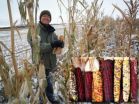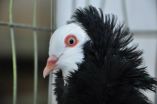(Press-News.org) We've all heard examples of animal altruism: Dogs caring for orphaned kittens, chimps sharing food or dolphins nudging injured mates to the surface. Now, a study led by the University of Colorado Boulder suggests some plants are altruistic too.
The researchers looked at corn, in which each fertilized seed contained two "siblings" -- an embryo and a corresponding bit of tissue known as endosperm that feeds the embryo as the seed grows, said CU-Boulder Professor Pamela Diggle. They compared the growth and behavior of the embryos and endosperm in seeds sharing the same mother and father with the growth and behavior of embryos and endosperm that had genetically different parents.
"The results indicated embryos with the same mother and father as the endosperm in their seed weighed significantly more than embryos with the same mother but a different father," said Diggle, a faculty member in CU-Boulder's ecology and evolutionary biology department. "We found that endosperm that does not share the same father as the embryo does not hand over as much food -- it appears to be acting less cooperatively."
A paper on the subject was published during the week of Jan. 21 in the Proceedings of the National Academy of Sciences. Co-authors on the study included Chi-Chih Wu, a CU-Boulder doctoral student in the ecology and evolutionary biology department and Professor William "Ned" Friedman, a professor at Harvard University who helped conduct research on the project while a faculty member at CU-Boulder.
Diggle said it is fairly clear from previous research that plants can preferentially withhold nutrients from inferior offspring when resources are limited. "Our study is the first to specifically test the idea of cooperation among siblings in plants."
"One of the most fundamental laws of nature is that if you are going to be an altruist, give it up to your closest relatives," said Friedman. "Altruism only evolves if the benefactor is a close relative of the beneficiary. When the endosperm gives all of its food to the embryo and then dies, it doesn't get more altruistic than that."
In corn reproduction, male flowers at the top of the plants distribute pollen grains two at a time through individual tubes to tiny cobs on the stalks covered by strands known as silks in a process known as double fertilization. When the two pollen grains come in contact with an individual silk, they produce a seed containing an embryo and endosperm. Each embryo results in just a single kernel of corn, said Diggle.
The team took advantage of an extremely rare phenomenon in plants called "hetero-fertilization," in which two different fathers sire individual corn kernels, said Diggle, currently a visiting professor at Harvard. The manipulation of corn plant genes that has been going on for millennia -- resulting in the production of multicolored "Indian corn" cobs of various colors like red, purple, blue and yellow -- helped the researchers in assessing the parentage of the kernels, she said.
Wu, who cultivated the corn and harvested more than 100 ears over a three-year period, removed, mapped and weighed every individual kernel out of each cob from the harvests. While the majority of kernels had an endosperm and embryo of the same color -- an indication they shared the same mother and father -- some had different colors for each, such as a purple outer kernel with yellow embryo.
Wu was searching for such rare kernels -- far less than one in 100 -- that had two different fathers as a way to assess cooperation between the embryo and endosperm. "It was very challenging and time-consuming research," said Friedman. "It was like looking for a needle in a haystack, or in this case, a kernel in a silo."
Endosperm -- in the form of corn, rice, wheat and other crops -- is critical to humans, providing about 70 percent of calories we consume annually worldwide. "The tissue in the seeds of flowering plants is what feeds the world," said Friedman, who also directs the Arnold Arboretum at Harvard. "If flowering plants weren't here, humans wouldn't be here."
INFORMATION:
-CU-
Contact:
Pamela Diggle, 303-550-3065
Pamela.diggle@colorado.edu
William "Ned" Friedman, 617-384-7744
ned@oeb.harvard.edu
Jim Scott, CU-Boulder media relations, 303-492-3114
Jim.Scott@colorado.edu
Can plants be altruistic? You bet, says new CU-Boulder-led study
2013-02-01
ELSE PRESS RELEASES FROM THIS DATE:
Disparities exist in kidney transplant timing
2013-02-01
Highlights
African Americans and individuals without private health insurance are less likely to receive a kidney transplant before needing dialysis.
Geographic region is not a major factor in determining whether a patient receives a kidney transplant before starting dialysis.
Nearly 90,000 people in the U.S. are waiting for a kidney transplant, and many will die before a suitable organ becomes available.
Washington, DC (January 31, 2013) — African-Americans and individuals without private health insurance are less likely than others to receive a kidney transplant ...
People having stroke should get therapy within 60 minutes of hospital arrival
2013-02-01
People having an ischemic stroke should receive clot-dissolving therapy – if appropriate -- within 60 minutes of arriving at the hospital, according to new American Stroke Association guidelines published in the American Heart Association journal Stroke.
Ischemic stroke, which accounts for nine in 10 strokes, is caused by a blood clot in the arteries leading to the brain. Calling 9-1-1 immediately after recognizing any of the warning signs of stroke -- and getting to a stroke center as fast as possible -- are still the most important steps for optimal stroke care.
During ...
African Programme for Onchocerciasis Control 1995– 2015: Model-estimated health impact and cost
2013-02-01
A relatively inexpensive program set up to combat river blindness, an infectious disease, has resulted in major health improvements in Africa, shows a study conducted by Erasmus University Medical Center researchers. The study, due to be published January 31 in PLOS Neglected Tropical Diseases, shows that US$250 million helped cure or prevent blindness, skin disease, severe itching, and other symptoms in millions of people. In collaboration with the Management of the African Programme for Onchocerciasis Control (APOC), the researchers calculated the health impact of APOC.
Onchocerciasis, ...
Active duty military personnel prone to sleep disorders and short sleep duration
2013-02-01
DARIEN, IL – A new study found a high prevalence of sleep disorders and a startlingly high rate of short sleep duration among active duty military personnel. The study suggests the need for a cultural change toward appropriate sleep practices throughout the military.
"While sleep deprivation is part of the military culture, the high prevalence of short sleep duration in military personnel with sleep disorders was surprising," said Vincent Mysliwiec, MD, the study's principal investigator, lead author and chief of Pulmonary, Critical Care and Sleep Medicine at Madigan ...
Mutant gene gives pigeons fancy hairdos
2013-02-01
SALT LAKE CITY, Jan. 31, 2013 – University of Utah researchers decoded the genetic blueprint of the rock pigeon, unlocking secrets about pigeons' Middle East origins, feral pigeons' kinship with escaped racing birds, and how mutations give pigeons traits like a fancy feather hairdo known as a head crest.
"Birds are a huge part of life on Earth, and we know surprisingly little about their genetics," especially compared with mammals and fish, says Michael D. Shapiro, one of the study's two principal authors and an assistant professor of biology at the University of ...
NYU physicists shine a light on particle assembly
2013-02-01
New York University physicists have developed a method for moving microscopic particles with the flick of a light switch. Their work, reported in the journal Science, relies on a blue light to prompt colloids to move and then assemble—much like birds flock and move together in flight.
The method offers the potential to enhance the design of a range of industrial products, including the architecture of electronics.
The study's authors were: Jeremie Palacci and Stefano Sacanna, post-doctoral fellows in NYU's Center for Soft Matter Research who devised the research; ...
Owl mystery unravelled: Scientists explain how bird can rotate its head without cutting off blood
2013-02-01
Medical illustrators and neurological imaging experts at Johns Hopkins have figured out how night-hunting owls can almost fully rotate their heads - by as much as 270 degrees in either direction - without damaging the delicate blood vessels in their necks and heads, and without cutting off blood supply to their brains.
In what may be the first use of angiography, CT scans and medical illustrations to examine the anatomy of a dozen of the big-eyed birds, the Johns Hopkins team, led by medical illustrator Fabian de Kok-Mercado, M.A., a recent graduate student in the Department ...
Scientist: Ozone thinning has changed ocean circulation
2013-02-01
According to a Johns Hopkins earth scientist, the hole in the Antarctic ozone layer has caused changes in the way that waters in those southern oceans mix – a situation that has the potential to alter the amount of CO2 in the atmosphere and eventually could have an impact on global climate change.
In a paper published in this week's issue of the journal Science, Darryn W. Waugh and his team show that subtropical intermediate waters in the southern oceans have become "younger" as the upwelling, circumpolar waters have gotten "older" – changes that are consistent with ...
Engineered oncolytic herpes virus inhibits ovarian and breast cancer metastases
2013-02-01
A genetically reprogrammed Herpes simplex virus (HSV) can cure metastatic diffusion of human cancer cells in the abdomen of laboratory mice, according to a new study published January 31 in the Open Access journal PLOS Pathogens. The paper reports on the collaborative research from scientists at the at the University of Bologna and specifically describes that the HSV converted into a therapeutic anticancer agent attacks breast and ovarian cancer metastases.
Past decades have witnessed significant progress in the ability to treat numerous cancers by means of surgery, ...
Target 'super-spreaders' to stop hepatitis C
2013-02-01
Each intravenous drug user contracting Hepatitis C is likely to infect around 20 other people with the virus, half of these transmissions occurring in the first two years after the user is first infected, a new study estimates.
The work, led by researchers from Oxford University, suggests that early diagnosis and treatment of Hepatitis C in intravenous drug users could prevent many transmissions by limiting the impact of these 'super-spreaders' (a highly infectious person who spreads a disease to many other people).
Working out 'who has infected who' in fast-spreading ...

